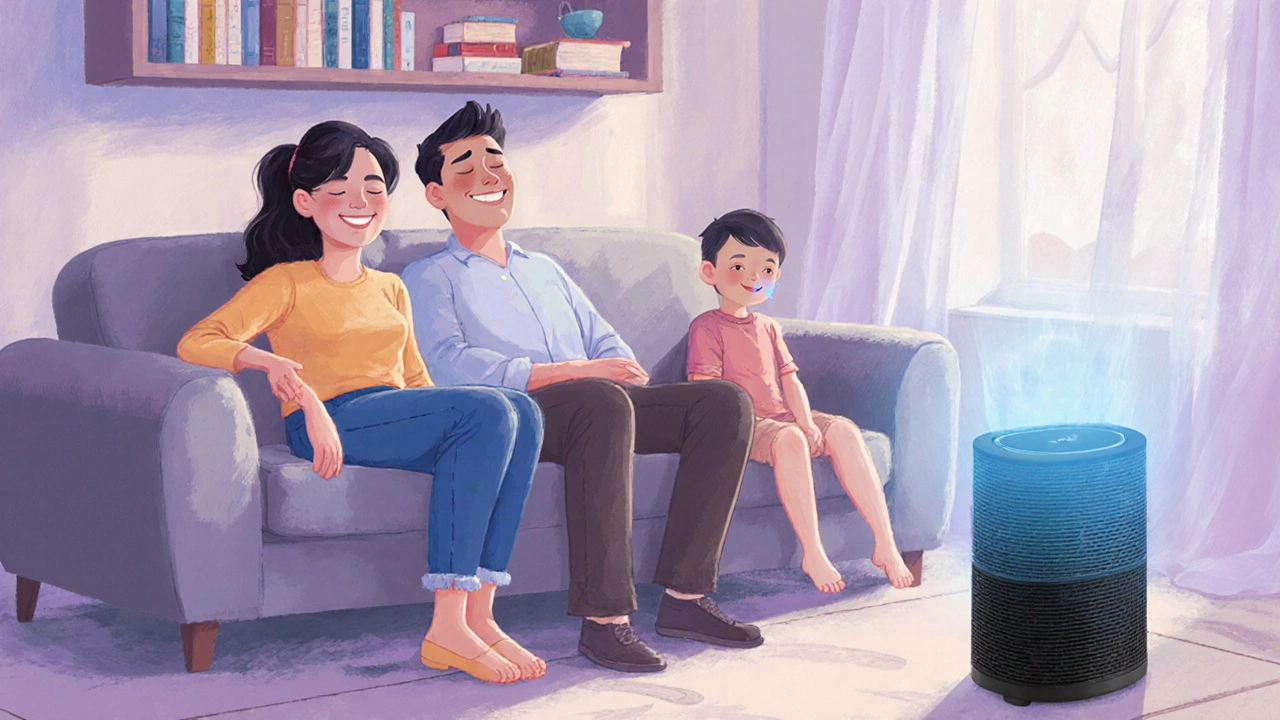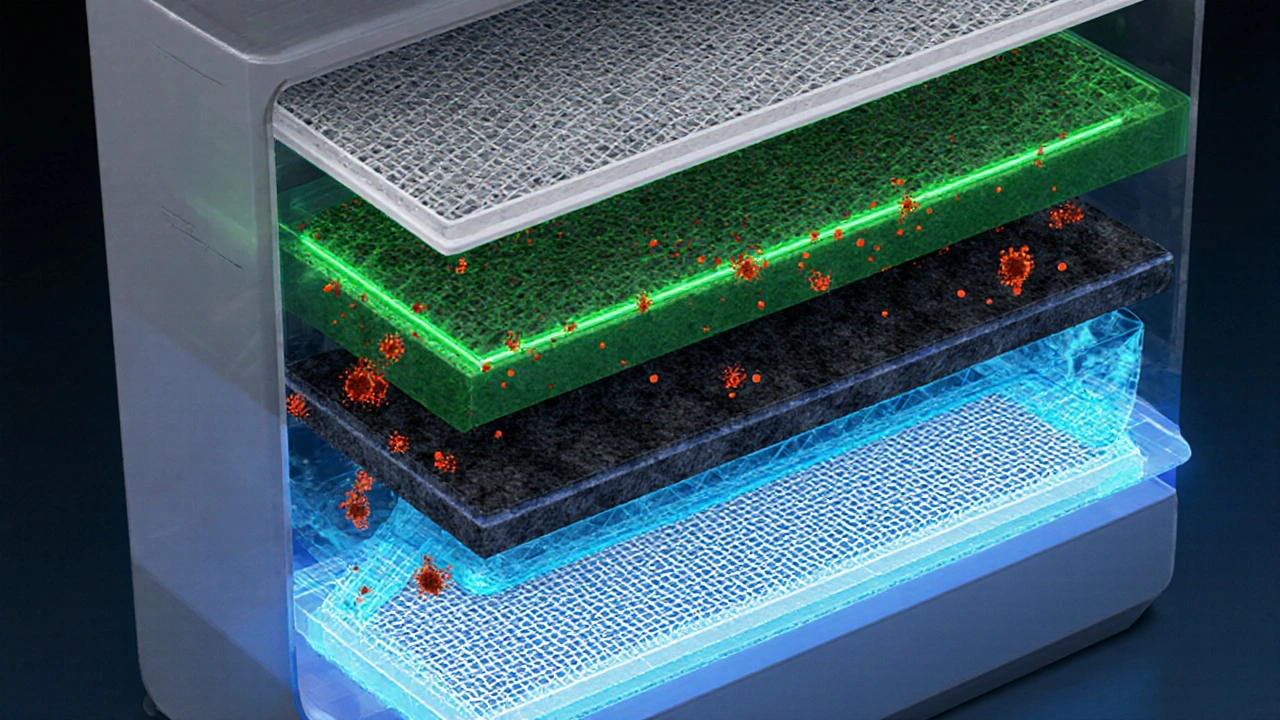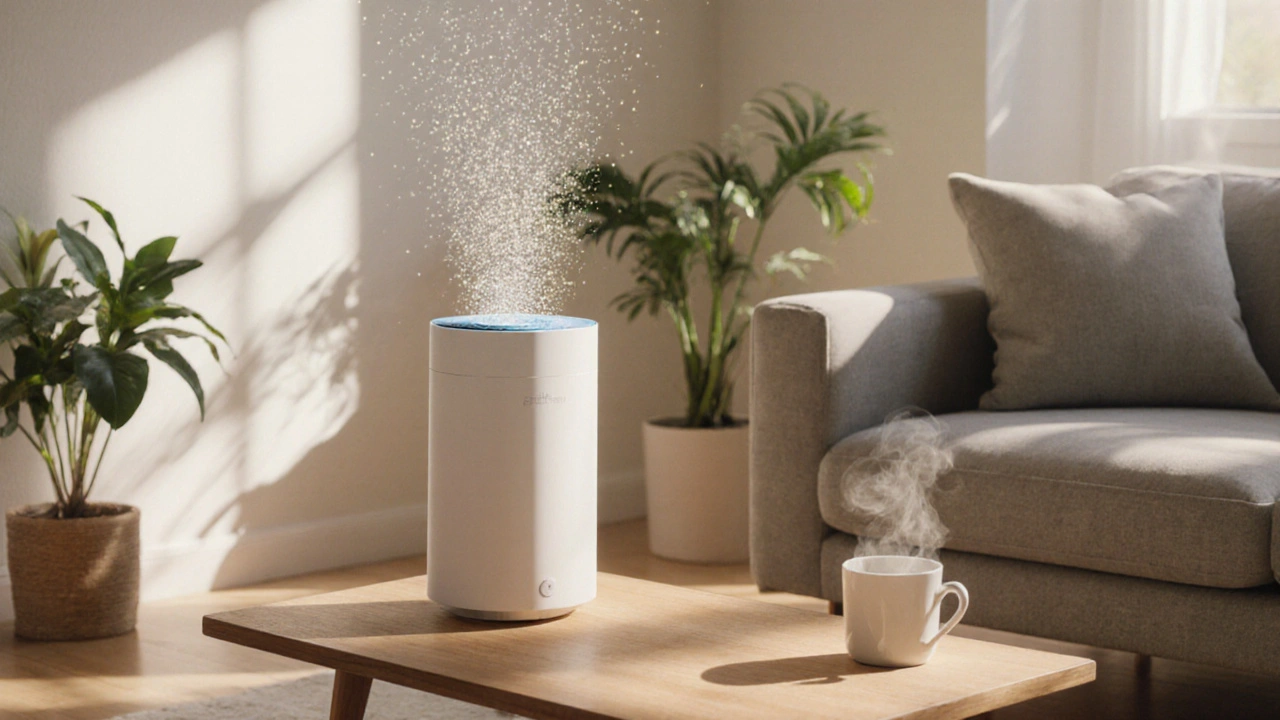Air purifier is a device that removes airborne contaminants using filtration, adsorption, or ionization technologies, often rated by Clean Air Delivery Rate (CADR) and designed to improve indoor air quality.
Why a Cough Often Signals Poor Air Quality
A persistent cough is the body’s alarm bell for irritated airways. Common triggers include dust mites, pollen, pet dander, mold spores, and volatile organic compounds (VOCs are chemicals released from paints, cleaning agents, and furnishings). When these irritants linger in a room, they settle on the throat lining, prompting reflex coughing. Studies from the Canadian Respiratory Society show that people living in homes with high particulate matter (PM2.5 particles smaller than 2.5µm) report cough frequency up to 40% more often than those in cleaner environments.
How Air Purifiers Attack the Root Causes
Modern air purifiers act on three fronts:
- Capture: physical filters trap particles.
- Adsorb: activated carbon binds gases and odors.
- Neutralize: UV‑C light or ionizers break down microbes.
Each step directly reduces the load of cough‑inducing agents. For example, a unit with a true‑HEPA filter removes 99.97% of particles down to 0.3µm, which includes most pollen, dust, and even some viruses. Meanwhile, an activated carbon layer scrubs away formaldehyde and benzene-two VOCs known to irritate the respiratory tract.
Key Technologies Explained
Below are the most common technologies you’ll encounter when shopping for a unit.
HEPA filter is a high‑efficiency particulate air filter that captures at least 99.97% of particles 0.3µm in size.HEPA filters excel at removing allergens, dust, and fine smoke particles, making them the go‑to choice for cough sufferers with seasonal allergies.
Activated carbon filter is a porous material that adsorbs gases, odors, and volatile organic compounds.These are essential when cooking fumes, cleaning sprays, or new furniture release VOCs that can trigger throat irritation.
UV‑C light is a ultraviolet wavelength (200‑280nm) that inactivates bacteria, viruses, and mold spores.While UV‑C doesn’t capture particles, it neutralizes living microbes that can cause post‑nasal drip and cough.
Ionic purifier is a device that releases charged ions to attract and settle airborne particles.Ionic units are quiet but often produce ozone-a respiratory irritant-so they’re less suitable for cough relief.
Comparing the Main Technologies
| Technology | Filtration Efficiency | Target Pollutants | Maintenance Frequency | Noise (dB) |
|---|---|---|---|---|
| HEPA | 99.97% @ 0.3µm | Dust, pollen, smoke, fine PM2.5 | Filter replace every 6‑12months | 30‑45 |
| Activated Carbon | 70‑90% VOC adsorption | Formaldehyde, benzene, cooking fumes | Carbon replace every 3‑6months | 25‑40 |
| UV‑C | 99% microbial kill | Bacteria, viruses, mold spores | Bulb replace annually | 20‑35 |
| Ionic | Varies, often <70% | Fine particles (via settling) | Electrodes clean quarterly | 15‑25 (but ozone risk) |

Understanding CADR and Its Role in Cough Management
Clean Air Delivery Rate (CADR) is a metric that quantifies the volume of filtered air a purifier delivers per minute (cubic feet per minute). A higher CADR means the device can clear a room of irritants faster, reducing the exposure time that fuels a cough. For a typical bedroom (150ft³), a purifier with a CADR of 150cfm can refresh the entire space every minute, dramatically lowering allergen concentrations.
Choosing the Right Unit for Your Cough Symptoms
When your primary goal is cough relief, evaluate the following criteria:
- Filter composition: Look for true‑HEPA plus an activated carbon stage.
- CADR rating: Match or exceed the room’s square footage (e.g., 200cfm for a 200‑ft² living room).
- Noise level: Below 40dB is ideal for bedrooms; louder units may disrupt sleep, indirectly worsening cough.
- Energy consumption: Units under 50W run cost‑effectively 24/7.
- Smart sensors: Some models adjust fan speed based on real‑time indoor air quality (IAQ) sensors, ensuring optimal filtration without manual tweaking.
Brands that consistently score high on these parameters include Coway, Blueair, and Levoit. Canadian consumer reports 2024 placed Coway’s AP‑1512HH at the top for cough‑related symptom improvement, noting a 35% reduction in night‑time coughing after two weeks of use.
Practical Tips to Maximize Cough Relief
- Place the purifier near the primary cough trigger-usually the bedroom or living room where you spend most of your time.
- Keep windows closed when the unit is running to prevent fresh outdoor pollutants from re‑entering.
- Replace HEPA filters every 6‑12months; a clogged filter can actually re‑emit particles.
- Clean the pre‑filter monthly; dust buildup reduces airflow and CADR.
- Combine the purifier with regular HVAC maintenance; a clean duct system works hand‑in‑hand with portable units.
Related Concepts and Next Steps
Understanding how indoor air quality (IAQ) influences respiratory health opens the door to broader interventions. After mastering air purification, you might explore:
- Humidity control: Maintaining 40‑60% relative humidity can thin mucus, easing cough.
- Ventilation strategies: Heat‑recovery ventilators (HRV) exchange stale indoor air without losing heat.
- Allergen‑proof bedding: Reduces dust‑mite exposure while you sleep.
- Prescription inhalers: For chronic coughs tied to asthma, a clinician’s guidance remains essential.
Each of these topics expands the “air quality → respiratory comfort” pathway, building a comprehensive plan that goes beyond a single device.

Frequently Asked Questions
Can an air purifier completely eliminate a cough?
No, a purifier reduces irritants but doesn’t treat underlying infections or chronic conditions. It works best alongside hydration, proper medication, and medical evaluation.
How often should I replace the HEPA filter?
Most manufacturers recommend replacement every 6‑12months, depending on usage and indoor pollutant levels. A noticeable drop in airflow or a warning light signals it’s time.
Do I need both a HEPA and an activated carbon filter?
For cough relief, yes. HEPA handles particles like dust and pollen, while carbon tackles gases and odors that also irritate the throat.
Will an ionic purifier worsen my cough because of ozone?
Potentially. Ozone is a known respiratory irritant. If you choose an ionic model, ensure it’s certified ozone‑free (<0.05ppm) or avoid it altogether.
How do I calculate the right CADR for my bedroom?
Measure the room’s volume (length×width×height). Aim for a CADR that equals or exceeds that number in cubic feet per minute. For a 10ft×12ft×8ft room (960ft³), a CADR of 200cfm will refresh the air roughly every 4‑5 minutes.
Is it safe to run an air purifier all night?
Yes, especially low‑noise models (<40dB). Continuous operation maintains a steady reduction in irritants, which can prevent cough spikes during sleep.


Helena Pearson
September 27, 2025 AT 01:28Imagine breathing the same air that mountain breezes carry, free of dust and sneaky VOCs 🌲✨. A true‑HEPA filter works like a microscopic net, snagging pollen, pet dander, and even the tiniest virus particles before they can irritate our throats. Pair it with an activated carbon layer and you’re basically giving your lungs a detox spa, soaking up formaldehyde and benzene that would otherwise provoke a stubborn cough. The UV‑C light adds a superhero punch, zapping microbes so they can’t spawn post‑nasal drip. In practice, people report waking up feeling less “scratchy” and more refreshed after a few weeks of clean indoor air. So if you’re battling a nagging cough, think of an air purifier as a silent guardian on the front lines of your breathing zone 😊.
Patricia Fallbeck
September 29, 2025 AT 10:19Wow, you’ve turned a simple appliance into a mystical altar for the lungs. Sure, a HEPA filter catches particles, but let’s not pretend it’s a cure‑all for every cough – many triggers are hidden deeper in our habits, not just the air. And that “UV‑C superhero” line? It’s more marketing hype than science for the average homeowner. Still, if you enjoy romanticizing gadgets, go ahead, but keep your expectations grounded.
Brett Snyder
October 1, 2025 AT 19:10Disregarding the real cause of coughs like smog outside is just dumb. Air purifiers alone cant fix bad outdoor air & u need to close windows.
Nidhi Jaiswal
October 4, 2025 AT 04:00Filters need regular replacement. If you ignore maintenance, the purifier becomes a dust collector rather than a cleaner
Sunil Sharma
October 6, 2025 AT 12:51Absolutely, keeping the HEPA filter fresh is key. Most manufacturers suggest swapping it out every 6‑12 months depending on usage. A quick visual check – if you see a noticeable dark layer – is a good indicator it’s time for a change.
Leah Robinson
October 8, 2025 AT 21:41Got one of these for my home office and the difference is night and day. The cough that used to keep me up at 2 am faded after a couple of weeks. It’s wild how clean air can make you feel more awake and less irritated. Keep breathing easy, folks! 😄
Abhimanyu Lala
October 11, 2025 AT 06:32Enough with the fluff.
RUCHIKA SHAH
October 13, 2025 AT 15:22In a way, the purifier acts as a silent mediator between us and the invisible world of particles. By reducing irritants, it subtly shifts our perception of comfort, reminding us that health often lives in the margins of daily routine.
Sam Moss
October 16, 2025 AT 00:13Reading about the cough‑inducing culprits feels personal when you’ve watched a loved one struggle through a night of hacking. Air purifiers can be the gentle hand that steadies the breath, especially when the house is filled with cooking aromas or new furniture off‑gassing. I’ve seen kids sleep through storms of allergens after we added a carbon filter. It’s like giving the whole family a breath of fresh hope.
Suzy Stewart
October 18, 2025 AT 09:03Don’t underestimate the power of a good carbon filter – it actually grabs those nasty VOCs that make your throat feel like sandpaper. Replace it on schedule and you’ll notice the air smelling cleaner, not just “less dusty”. 🎯
Traven West
October 20, 2025 AT 17:54Stop worshipping gadgets; hygiene matters more.
Ryan Moodley
October 23, 2025 AT 02:44While the poetic vibe is nice, let’s not forget that no device can replace good ventilation. If you seal your house too tight, you’ll trap CO₂ and create a different health hazard. Balance is essential, not blind faith in tech.
carol messum
October 25, 2025 AT 11:35Contemplating the invisible particles that swirl around us can be humbling. An air purifier, in its quiet way, becomes a modest tool for reclaiming a breath of clarity amidst the chaos of modern life.
Jennifer Ramos
October 27, 2025 AT 19:25Totally agree – a well‑chosen purifier is like an extra layer of protection for the whole household. Pair it with regular cleaning and you’ll see fewer coughs, fewer sneezes, and happier noses. 😊
Grover Walters
October 30, 2025 AT 04:16The discourse surrounding indoor air quality often overlooks the epistemic humility required when evaluating technological interventions. While empirical data supports HEPA efficacy, one must also consider the socioeconomic barriers that limit widespread adoption. Thus, the conversation should transcend merely technical specifications and address equitable access.
Amy Collins
November 1, 2025 AT 13:06Sure, it’s cool and all, but at the end of the day it’s just another gadget you have to maintain and replace filters for.
amanda luize
November 3, 2025 AT 21:57Ever wonder why big air purifier companies push carbon filters? It’s a cash‑grab scheme that masks the real issue: the government’s hidden agenda to keep us breathing “controlled” air while they monitor our health data. Stay woke.
Chris Morgan
November 6, 2025 AT 06:48While many praise these devices, the evidence for long‑term health benefits remains inconclusive.
Pallavi G
November 8, 2025 AT 15:38When you think about the persistent cough that keeps waking you up at night, the first instinct is often to reach for a cough syrup or a decongestant.
However, the root cause often lies in the quality of the air you breathe while you sleep.
Studies have shown that indoor PM2.5 levels can be higher than outdoor levels in many households, especially those with poor ventilation.
A good HEPA filter captures particles as small as 0.3 microns, which includes most allergens such as pollen, dust mite debris, and even some virus fragments.
Adding an activated carbon layer tackles gaseous pollutants like formaldehyde, benzene, and the volatile organic compounds released by new furniture or cleaning products.
The combination of these two technologies creates a synergistic effect that reduces both particulate and chemical irritants.
People who install a properly sized purifier report a measurable drop in cough frequency within a week or two.
In addition, the reduced allergen load can improve sleep quality, making you feel more rested and less fatigued during the day.
It is important to match the CADR rating of the unit to the size of the room; an undersized purifier will struggle to keep up with the pollutant load.
Routine maintenance, such as replacing the HEPA filter every 6‑12 months and the carbon filter every 3‑6 months, ensures the system continues to work efficiently.
Neglecting filter changes can actually worsen indoor air quality because the filters become saturated and may re‑release captured particles.
Some models also incorporate UV‑C light or ionization, which can further reduce microbial contaminants, though you should verify that the ionizer does not produce excessive ozone.
From a cost perspective, the initial investment pays off when you consider the reduced need for over‑the‑counter cough remedies and fewer doctor visits.
Moreover, cleaner air benefits everyone in the household, including pets and children, who are often more sensitive to airborne irritants.
In summary, while an air purifier is not a magical cure, it is a practical, evidence‑based tool that addresses one of the most common triggers of chronic coughing.
Rafael Lopez
November 11, 2025 AT 00:28Great discussion, everyone. If you’re considering a purchase, check the unit’s CADR against your room’s square footage, read user reviews about filter lifespan, and don’t forget to factor in the ongoing cost of replacements. A well‑maintained purifier can be a quiet ally in the fight against coughs and indoor pollutants.